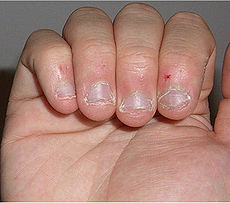- Nail biting
-
Nail biting Classification and external resources 
Fingers of a nail-biter.ICD-10 F98.8 (ILDS F98.810) ICD-9 307.9 Onychophagia, or nail biting, is a common oral compulsive habit in children and adults.
Contents
Classification
Nail biting is considered an impulse control disorder in the DSM-IV-R; the ICD-10 classifies it as "other specified behavioral and emotional disorders with onset usually occurring in childhood and adolescence."
Health consequences of nail biting
Biting nails can lead to broken skin on the cuticle. When cuticles are improperly removed, they are susceptible to microbial and viral infections such as paronychia. Saliva may then redden and infect the skin.[1]
Nail biting is also related to dental problems, such as gingival injury and malocclusion of the anterior teeth.[2][3]
It can also transfer pinworms or bacteria buried under the surface of the nail from the anus region to the mouth.[4][5] When the bitten-off nails are swallowed stomach problems can develop.[3]
Medical literature reports cases of fingernails being severely deformed after years of nail biting.[6]
Treatment
The most common treatment, which is cheap and widely available, is to apply a clear, bitter-tasting nail polish to the nails. The bitter flavor discourages the nail-biting habit.[7] Mouthpieces that prevent nail-biting are also available.[8]
Behavioral therapy is beneficial when simpler measures are not effective. Habit Reversal Training (HRT), which seeks to unlearn the habit of nail biting and possibly replace it with a more constructive habit, has shown its effectiveness versus placebo in children and adults.[9][10] In addition to HRT, stimulus control therapy is used to both identify and then eliminate the stimulus that frequently triggers biting urges.[11]
Finally nail cosmetics can help to ameliorate nail biting social effects.[12]
Children can wear footed pajamas as a reminder not to bite their toenails.[13]
Epidemiology
Nail biting affects about 30 percent of children between 7 to 10 years of age and 45 percent of teenagers.[1] The ten fingernails are usually equally bitten and approximately the same degree.[1] It may be underrecognized since individuals tend to deny or be ignorant of its negative consequences complicating its diagnosis.[14]
Related disorders
Related body-focused repetitive behaviors include dermatillomania (skin picking), dermatophagia (skin biting), and trichotillomania (the urge to pull out hair).[14] Nail biting appeared in a study to be more common in men with eating disorders than those without them.[15] It is also more common among children and adolescents with obsessive–compulsive disorder.[16]
References
- ^ a b c Leung AK, Robson WL (1990). "Nailbiting". Clin Pediatr (Phila) 29 (12): 690–2. doi:10.1177/000992289002901201. PMID 2276242.
- ^ Krejci CB (June 2000). "Self-inflicted gingival injury due to habitual fingernail biting". J. Periodontol. 71 (6): 1029–31. doi:10.1902/jop.2000.71.6.1029. PMID 10914808.
- ^ a b Tanaka OM, Vitral RW, Tanaka GY, Guerrero AP, Camargo ES (August 2008). "Nailbiting, or onychophagia: a special habit". Am J Orthod Dentofacial Orthop 134 (2): 305–8. doi:10.1016/j.ajodo.2006.06.023. PMID 18675214.
- ^ Sung JF, Lin RS, Huang KC, Wang SY, Lu YJ (November 2001). "Pinworm control and risk factors of pinworm infection among primary-school children in Taiwan". Am. J. Trop. Med. Hyg. 65 (5): 558–62. PMID 11716114. http://www.ajtmh.org/cgi/pmidlookup?view=long&pmid=11716114.
- ^ Baydaş B, Uslu H, Yavuz I, Ceylan I, Dağsuyu IM (2007). "Effect of a chronic nail-biting habit on the oral carriage of Enterobacteriaceae". Oral Microbiol. Immunol. 22 (1): 1–4. doi:10.1111/j.1399-302X.2007.00291.x. PMID 17241163.
- ^ Jabr FI (September 2005). "Severe nail deformity. Nail biting may cause multiple adverse conditions". Postgrad Med 118 (3): 37–8, 42. PMID 16201307.
- ^ Allen KW (March 1996). "Chronic nailbiting: a controlled comparison of competing response and mild aversion treatments". Behav Res Ther 34 (3): 269–72. doi:10.1016/0005-7967(95)00078-X. PMID 8881096. http://linkinghub.elsevier.com/retrieve/pii/000579679500078X.
- ^ Max, Arthur (2007-09-08). "Dutchman Offers 'Cure' for Nail Biting". The Washington Post. http://www.washingtonpost.com/wp-dyn/content/article/2007/09/07/AR2007090701271.html. Retrieved 2008-03-22.
- ^ Twohig MP, Woods DW, Marcks BA, Teng EJ (January 2003). "Evaluating the efficacy of habit reversal: comparison with a placebo control". J Clin Psychiatry 64 (1): 40–8. doi:10.4088/JCP.v64n0109. PMID 12590622. http://www.psychiatrist.com/privatepdf/2002/v64n01/v64n0109.pdf.
- ^ Woods DW, Murray LK, Fuqua RW, Seif TA, Boyer LJ, Siah A (December 1999). "Comparing the effectiveness of similar and dissimilar competing responses in evaluating the habit reversal treatment for oral-digital habits in children". J Behav Ther Exp Psychiatry 30 (4): 289–300. doi:10.1016/S0005-7916(99)00031-2. PMID 10759325. http://linkinghub.elsevier.com/retrieve/pii/S0005791699000312.
- ^ Penzel, Fred. "Skin picking and nail biting: related habits". Western Suffolk Psychological Services. http://westsuffolkpsych.homestead.com/skinpicking.html. Retrieved 2008-03-22.
- ^ Iorizzo M, Piraccini BM, Tosti A (March 2007). "Nail cosmetics in nail disorders". J Cosmet Dermatol 6 (1): 53–8. doi:10.1111/j.1473-2165.2007.00290.x. PMID 17348997.
- ^ RM Bakwin, H Bakwin (1940). Psychologic care of the preschool child. The Journal of Pediatrics. http://linkinghub.elsevier.com/retrieve/pii/S0022347640801236.
- ^ a b Bohne A, Keuthen N, Wilhelm S (2005). "Pathologic hairpulling, skin picking, and nail biting". Ann Clin Psychiatry 17 (4): 227–32. doi:10.1080/10401230500295354. PMID 16402755.
- ^ Mangweth-Matzek B, Rupp CI, Hausmann A, Gusmerotti S, Kemmler G, Biebl W (2010). "Eating disorders in men: current features and childhood factors". Eat Weight Disord 15 (1–2): e15–22. PMID 20571316.
- ^ Grant JE, Mancebo MC, Eisen JL, Rasmussen SA (January 2010). "Impulse-control disorders in children and adolescents with obsessive–compulsive disorder". Psychiatry Res 175 (1–2): 109–13. doi:10.1016/j.psychres.2009.04.006. PMC 2815218. PMID 20004481. http://www.pubmedcentral.nih.gov/articlerender.fcgi?tool=pmcentrez&artid=2815218.
Emotional and behavioral disorders (F90–F98, 312–314) Emotional and behavioral ADHD · Conduct disorder (ODD) · emotional disorder (Separation anxiety disorder) · social functioning (Selective mutism, RAD, DAD) · Tic disorder (Tourette syndrome) · Speech (Stuttering, Cluttering) · Movement disorder (Stereotypic) · Nose-picking · Nail bitingCategories:- Fingers
- Habits
- Nails (anatomy)
- Eating behaviors
- Conditions of the skin appendages
Wikimedia Foundation. 2010.
